This summer spaghetti is made with earthy spinach and succulent asparagus, lightly sautéed with garlic, finely chopped basil and a little lemon, then tossed through lovely al dente pasta with a sprinkling of Parmesan.

The recipe starts by melting butter and olive oil together and then lightly frying garlic to release all that gorgeous flavour. You'll then add vibrant greens in the form of asparagus, spinach and peas, as well as basil for some aromatic notes of peppery freshness.
Next, you'll toss in al dente pasta (for this recipe, you definitely want some bite) and a generous handful of grated Parmesan (or veggie alternative) to bring so much umami (savoury) flavour to the dish.

Finally, lemon juice add a little acidity to really brighten the meal and a ladleful of reserved water from the pasta pot loosens everything to produce a bare-there yet full of flavour sauce.

Whatever weather you enjoy this beautiful green pasta dish in, it's so fresh tasting and for me, just screams sunshine on a plate.
Here's the full recipe for my simple summer spaghetti with garlic and lemon.
Ingredients
- 300 g (11 oz) dried spaghetti
- 2 tbsp olive oil
- 2 tbsp salted butter
- 50 g (6 cups) fresh spinach shredded
- 150 g (5 oz) asparagus cut into inch pieces
- 4 cloves garlic minced
- 15 g (¼ cup) fresh basil finely chopped (plus a little to garnish)
- 150 g (1 cup) peas
- 1 lemon juice only (about 2 tbsp)
- 50 g (½ cup) Parmesan or vegetarian hard cheese alternative finely grated
- salt and black pepper to taste
Instructions
Set the pasta to cook in plenty of salted boiling water - it’ll need about 10 minutes to become al dente.
Melt the butter and olive oil in the pan over a low heat. Add the garlic and fry for a minute.

Add the asparagus, spinach and basil.
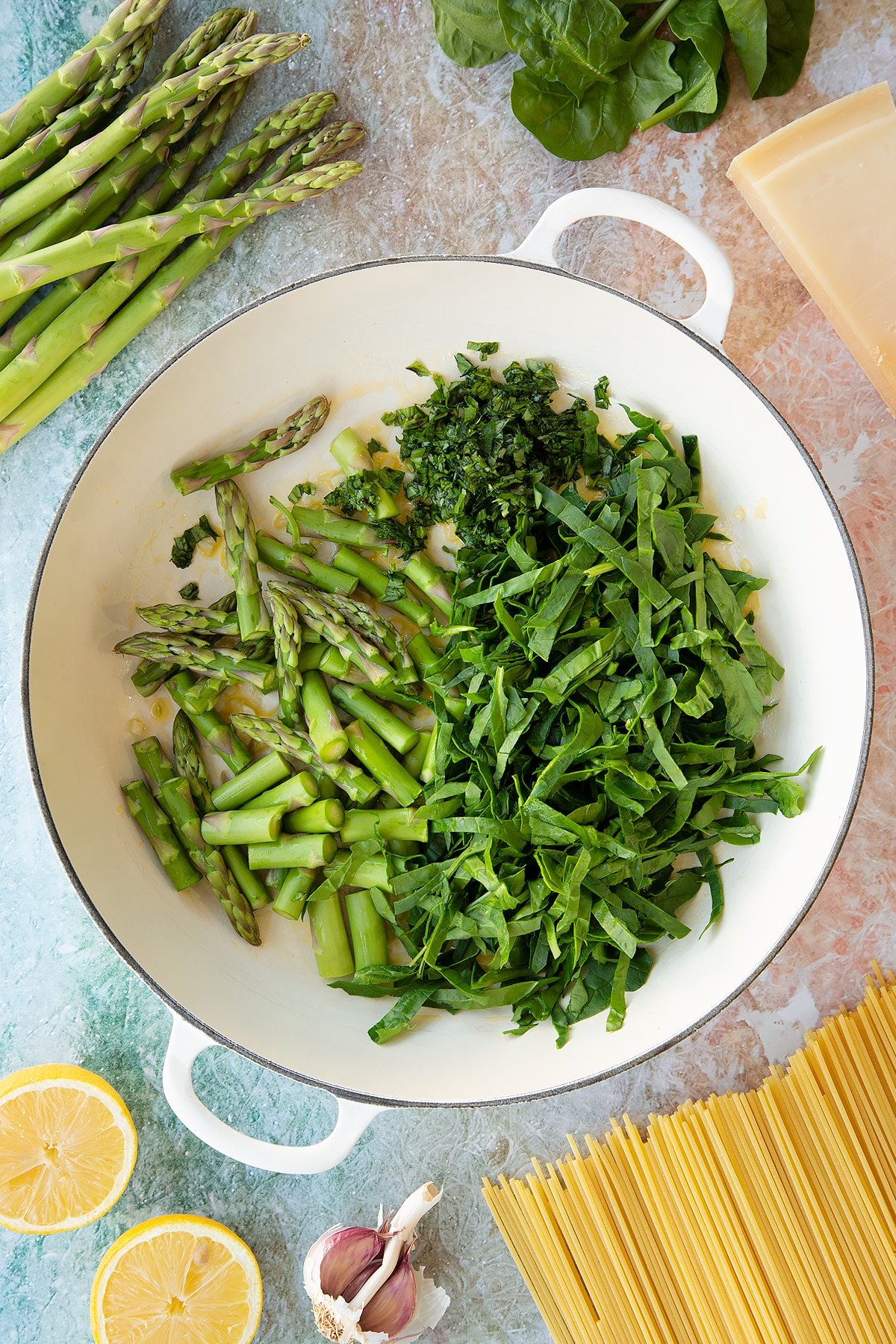
Fry very gently for a couple of minutes until the leaves are wilted.

Add the peas.

Fry for 2 more minutes.
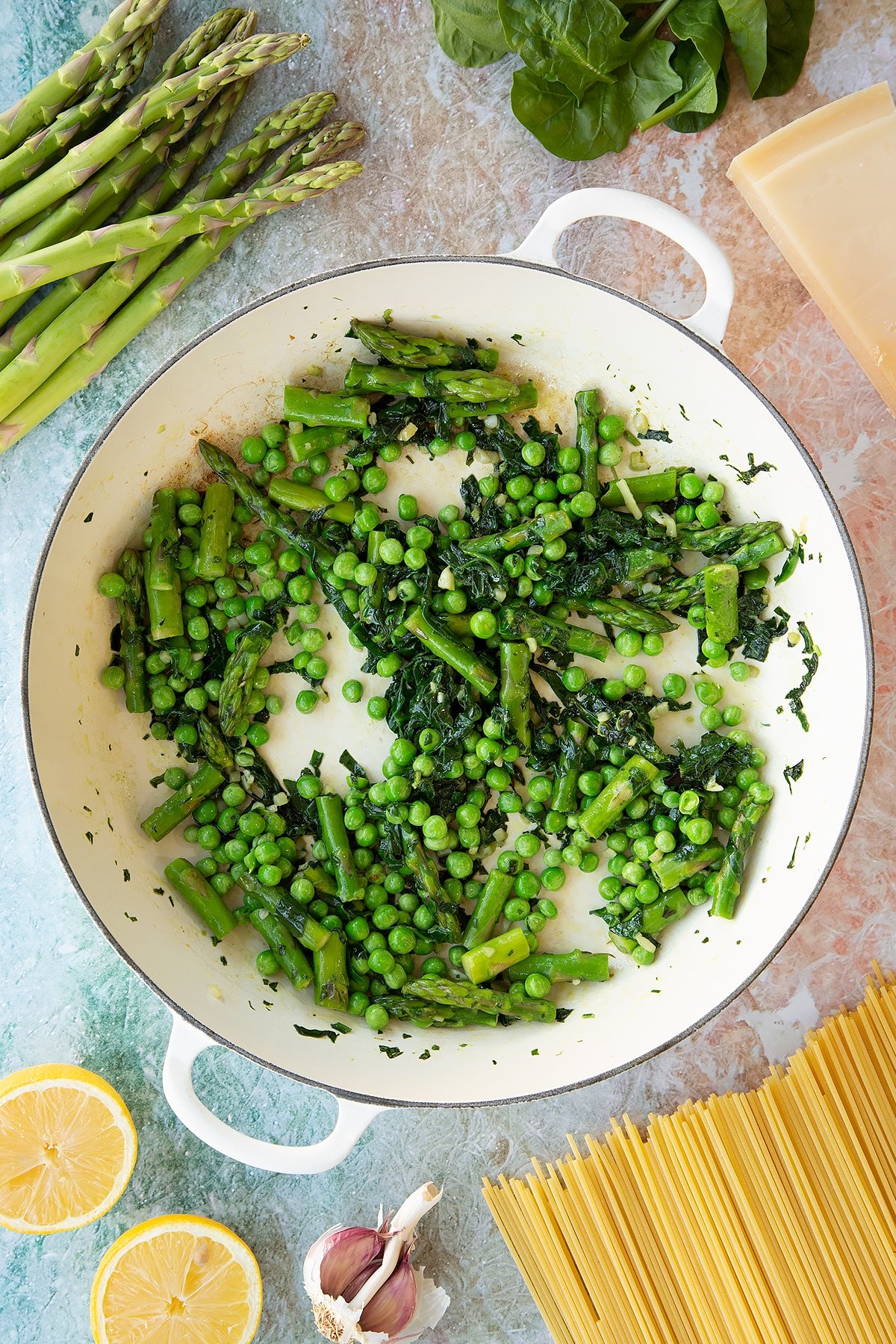
Drain the pasta, reserving a cup of cooking water and add to the pan.

Add the grated Parmesan and a pinch of salt and pepper.

Stir, then add the lemon juice and a ladleful of the reserved cooking water. Stir through, taste and season further if needed.

Serve immediately and enjoy!

While delicious on its own, this pasta is lovely with crusty bread, fresh salad and, for the grown-ups, a glass of crisp white wine, such as pinot grigio.
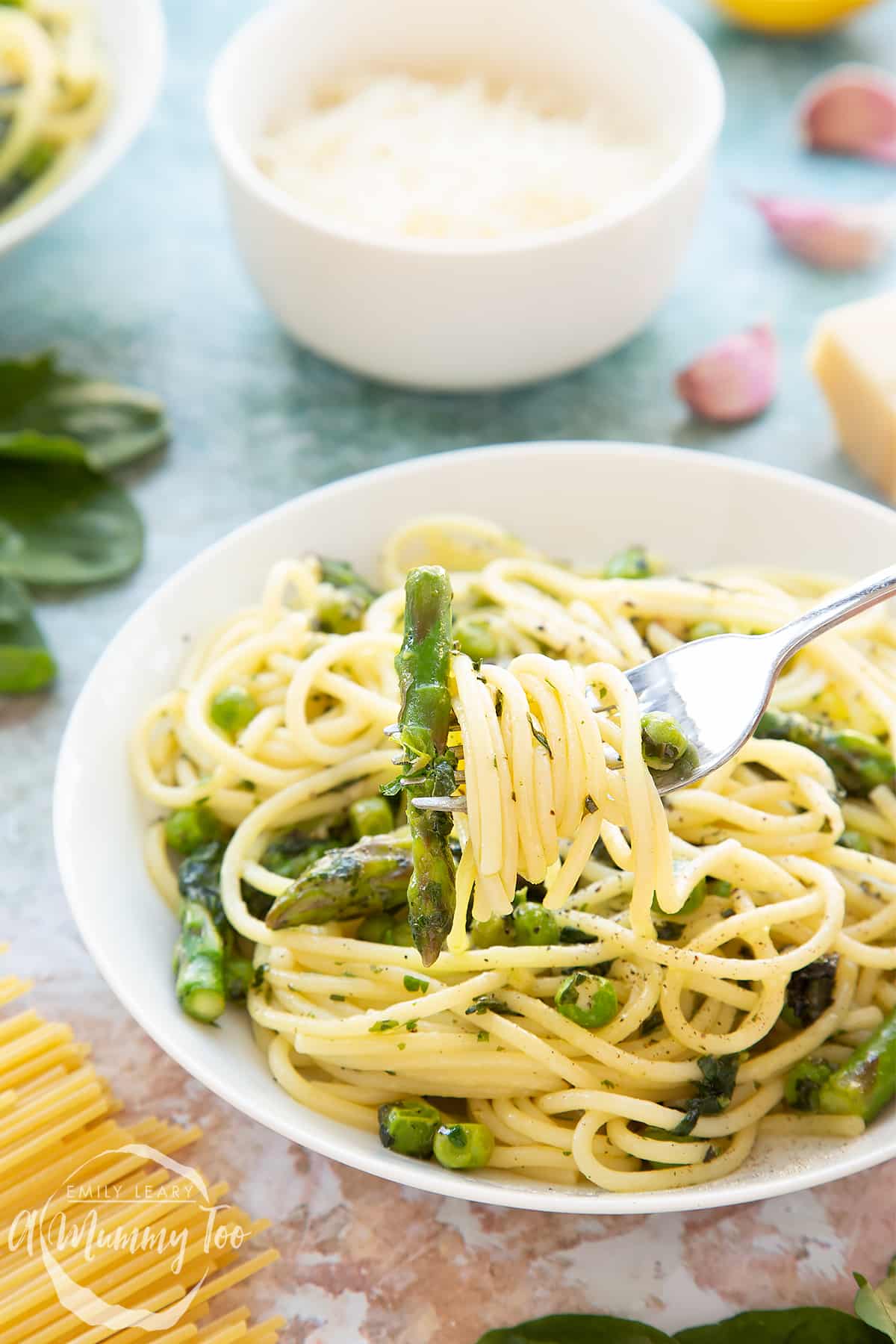
How will you enjoy yours?
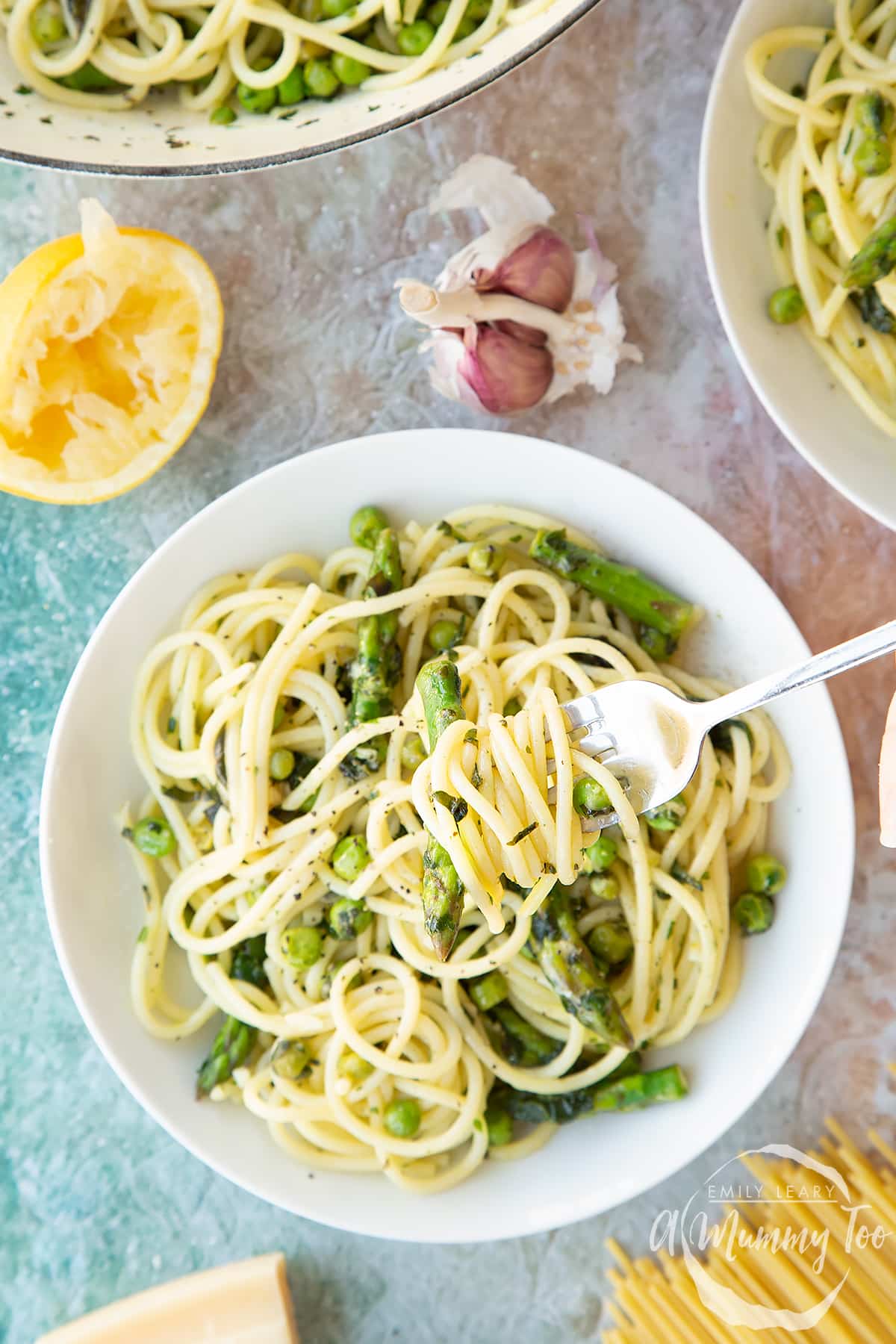
Pointers, tricks and troubleshooting tips for the perfect summer spaghetti
Is summer spaghetti easy to make?
This is the perfect meal to make on a summer's evening when you just want something quick and easy so you can get back out and enjoy the warm weather.
This spaghetti dish is super simple and can be on the table in under 20 minutes. Whilst the spaghetti is cooking, you'll have plenty of time to prepare the asparagus, spinach, peas and basil that make this dish so delightfully aromatic, flavourful and pleasingly green.
Once the pasta and veggies are ready, bring them together with a cup of the pasta cooking water to help loosen things up. A grating of parmesan if you're using and a squeeze of lemon finish off this dish with a bit of depth and zing. Enjoy!
Will I need any special equipment for this summer spaghetti?
Everything you need for this recipe should be easy to find in the average kitchen. The main things you'll need are a chopping board and knife to prepare the asparagus, spinach, and basil, a fine grater for the cheese, and two large pans to do the cooking in.
There is a full list of suggested equipment on the recipe card below.
How can I tell if asparagus has gone off?
Over time, asparagus will dry out and wilt, becoming really floppy instead of firm. Asparagus is one of those vegetables that is best eaten as fresh as possible, so try and use it within a day or two of purchase. It will keep longer than this but it does lose flavour and texture quickly.

Is summer spaghetti suitable for vegetarians?
This recipe can easily be made vegetarian by simply using a vegetarian hard cheese instead of Parmesan.
Lots of hard cheeses these days are made with vegetable rennet, but proper Parmesan is always made with animal rennet as the name is protected in Europe and must be made according to an agreed traditional recipe and methodology.
Double check all of your ingredients labels to make sure that they are suitable for vegetarians. And also check anything extra you intend to serve the recipe with.
Is summer spaghetti recipe suitable for vegans?
As it is, this recipe is not vegan because it contains butter and parmesan. It's really easy to make a vegan version of this recipe, though.
First, use a little extra olive to cook the garlic and veggies in rather than butter. You can then replace the parmesan with a plant-based alternative (I really like Violife Prosociano wedge) or try adding a teaspoon of nutritional yeast. Taste and add more, if required.
You should also make sure your spaghetti is also vegan. Most dried pasta is just made with durum wheat, but some might contain egg.
Double check all of your other ingredients labels to make sure that they are suitable for vegans. Don't forget to also check anything extra you intend to serve the recipe with.
Is this summer spaghetti recipe gluten-free?
I've made this summer spaghetti using wheat-based pasta so it is not gluten-free. You can easily switch this for your favourite gluten-free pasta. Buckwheat spaghetti works particularly well with the asparagus and spinach.
Double check all of your other ingredients labels to make sure that they are gluten-free. Don't forget to also check anything extra you intend to serve the recipe with.
Is summer spaghetti keto-friendly?
As one of the main ingredients of this recipe is wheat spaghetti, so it would be too high in carbohydrates to be considered keto-friendly.
You could of course use this recipe to make a keto version using courgette spaghetti instead. Peas are also sometimes considered too high in carbs to be keto-friendly, so you could try replacing these with green beans, if you like.
Is summer spaghetti healthy?
This summer spaghetti is a good mid-week dinner with a lovely variety of green and plenty of energy from the pasta.

Head down to the recipe card below if you would like some nutritional information. All the figures are estimates based on publicly available data.
Is this summer spaghetti safe to eat while pregnant?
Wash the veggies and herbs before use, and check the cheese you are using is made with pasteurised milk.
Make sure all the ingredients are in good condition and this meal is prepared safely and hygienically.
Check the advice specific to your country as food production laws and health advice vary. In the UK, the NHS offers a guide on foods to avoid in pregnancy.
A Mummy Too does not offer medical advice. Please seek help from a medical professional if you need further information or have any concerns.
Is summer spaghetti suitable for babies and toddlers?
If you are making this for young children or babies, the NHS recommends that you leave out the salt.
Always give food at an appropriate size and shape for your baby or child. Cut small, round foods, like grapes and cherry tomatoes, into small pieces. It's important that you consider this when preparing every aspect of their meal.
Always keep babies supported upright while eating and supervise your baby when they’re eating in case they start to choke.
The NHS has some fantastic resources on their website on what to feed babies and young children.
A Mummy Too does not give medical advice. If you have any questions or concerns please speak to a health professional.
What goes well with summer spaghetti?
This green spaghetti is perfect on a summer evening - it's a satisfying meal all by itself and so quick to prepare, you won't have to be standing over a stove too long on a hot day.
If you want to make this dish go a bit further, why not serve with a bowl of fresh salad and some crusty bread? Throw some fresh basil on top to garnish. Even some edible flowers, if you have some to hand, would look very pretty.
For the grown-ups, a glass of crisp white wine, such as pinot grigio goes very well.
Can I make this recipe without asparagus?
If you don't have any asparagus, you could replace it with another green vegetable like courgette or Tenderstem broccoli. Ideally, aim for whatever is in season locally.
I haven’t got any peas can I use green beans?
Yes, I do love the burst of sweetness you get from the peas but green beans would work equally well. Trim down to about 2cm (1 inch) pieces and throw in when the spinach has wilted.

Can I add extra veggies to this summer spaghetti?
Yes, if you like. At the moment this dish is a bit more spaghetti than veg in each portion so if you want to have more vegetable packed servings then go ahead add some more.
This is also a great way to get an extra portion out of the meal, and extra veg into the kids. Either just add around half as much again of asparagus, spinach, and peas, or add some different veggies too. Keep it green with broccoli, or add some colour with rainbow chard.
How should I store this summer spaghetti? How long will it keep?
Once cooled, this summer spaghetti needs to be kept covered and placed immediately into the fridge. I find spaghetti without much sauce has a tendency to stick together so before putting your leftovers in the fridge stir through an extra drizzle of olive oil to help stop the pasta from sticking together.
When stored correctly this summer spaghetti will keep for 2-3 days in the fridge.
Can I leave summer spaghetti out on the counter?
Other than when serving, this dish shouldn't be left out on the counter for food safety reasons. It's much easier for bacteria to spread on food left out, increasing the risk of foodborne illness. Make sure to get any leftovers into the fridge as soon as you can - certainly within 1 hour or 30 minutes on a hot day.
Can I make summer spaghetti ahead?
This recipe is such a quick one to make there's not much you can do to get ahead. The pasta and vegetables taste better freshly cooked and served straight away.
That said, this recipe also works well cold as a summer pasta salad so you could make it ahead and keep it in the fridge until you're ready to serve.
Before transferring to the fridge, toss through an extra tablespoon of olive oil to help stop the spaghetti from sticking together.
Can I keep summer spaghetti in the refrigerator?
Yes, any leftovers need to be kept in the fridge to keep them fresh. Allow the pasta to cool before putting it into the fridge as quickly as possible. Don't leave it sitting out for more than an hour - less on hot days.
Can I freeze this summer spaghetti?
Personally, I don't usually freeze this recipe as it's so quick to make and the spaghetti has a tendency to go a bit soggy or rubbery by the time it's been frozen and then reheated. The reheated cheese can also turn it greasy.
However, if you know you won't get through the leftovers, freezing is a great option to avoid food waste.
Try and cook the spaghetti al dente to start with so it's still got a bit of bite. Divide the leftovers into portions, putting them into a reusable freezer bag or container, then label with the date and what's inside.
This summer spaghetti will keep in the freezer for up to three months. Thaw out in the fridge overnight before reheating - don't try to cook from frozen. Once thawed, reheat and consume within 24 hours and don't refreeze.

What is the best way to reheat summer spaghetti?
Firstly, this summer spaghetti is great cold so you might not even need to heat it up! If you do prefer it warmed through, then the microwave or stovetop can be used. Bear in mind the spaghetti will become softer as you heat it up. Only reheat food once.
To microwave, transfer into microwave-safe bowls and loosely cover, then heat on full power for 2-4 minutes, stirring halfway through. Make sure the food is piping hot all the way through before serving.
To heat on the hob, pile the summer spaghetti in, add a few tablespoons of water if you think it might start to stick to the pan. Heat over a medium hob for about 10 minutes, stirring regularly so it doesn't stick. Check the food is piping hot before serving.
Can I make summer spaghetti in a different quantity?
If you want to make more or less of this recipe then go right ahead. If you're making more, make sure to use a pan large enough to hold everything comfortably at the end when the spaghetti is combined with the asparagus and other veggies.
Look for the recipe card below. You'll see the servings near the top left. To change this to the number you want to make just click or hover over that number and a little slider will pop up.
You can move the slider up or down to get the amount you want to make. All the ingredient quantities will update automatically for you so that everything is in the right ratios.
Can I make this summer spaghetti with a food processor?
I wouldn't usually get out the food processor for this recipe as it's easy enough to roughly chop the asparagus and spinach down to size.
However, you can use a food processor to break Parmesan or other hard cheese down to a fine power, so this could be a great option if you don't have a fine grater.
If you are cooking for kids that don't like certain vegetables, or different textures put them off, you can try popping the veg in the food processor after frying, along with the cheese to make a sort of asparagus spinach pesto, which you could then stir through the pasta. I haven't tried this so let me know how it works out for you.
How can I make sure this summer spaghetti is perfectly cooked?
This recipe is super quick, and there's not much that can go wrong. I generally recommend reading the whole recipe, then doing all the weighing and chopping before you start cooking, since that leaves much less room for mistakes.
Once you've got the spaghetti on the boil in plenty of salted water, make a start on the veg, starting by gently frying off the garlic. Make sure you don't have the heat too high, stir regularly and be careful it doesn't burn - burnt garlic will make your finished dish taste bitter. Add in the chopped spinach, asparagus, and basil to fry for a minute or two until the leaves have wilted, then add the peas.
By this point, the pasta will be almost ready. You want it to have some bite as it's just as much a star as the veggies in this dish. Scoop out a ladle of pasta water before draining, then add the drained spaghetti into the pan with the vegetables.
Add the parmesan and stir through before you add the reserved water so that it doesn't cause the cheese to melt in a lump. Add the lemon juice, give everything a good stir, season to taste and serve straight away.

Why did my summer spaghetti turn out hard and dry?
Check the cooking instructions on your spaghetti as some will take longer than the 8-10 minutes mine generally take to cook. If you're using a wholewheat spaghetti, these often have a longer cooking time.
Before you drain the pasta, make sure to scoop out a ladleful of the cooking water so you can add this back to make a light sauce and help everything come together. The dish will still work if you forget to do this but might turn out a bit dry. You can add an extra drizzle of olive oil to help things along if you like or a splash water from the kettle, but that won't benefit from the starch in the cooking water.
Finally, if you have the heat too high, you may scorch your pasta or veggies, leaving hard, bitter pieces in your final dish.
Why did my summer spaghetti turn out wet with soft veggies?
Did you use quick cook spaghetti? The spaghetti I used takes 8-10 minutes to get to al dente (with bite). Follow the instructions on your packet as some cook more quickly than this and give it a taste as soon as it softens so you can tell when it's almost done. Don't throw it at the wall - that's a myth.
The veggies for this recipe only need to cook for a few minutes, just to heat through, so they shouldn't turn out soft. If they have been cooked for too long they may overly soften and lose their vibrant colour, but they will still taste ok.
How can I add/change the flavours in this summer spaghetti dish?
You can play around with all the elements of this recipe depending on what you have in the fridge and cupboard.
Try using different vegetables like Tenderstem broccoli or green beans. You can also use different soft herbs to replace the basil, such as chives or parsley.
Wholewheat or buckwheat spaghetti goes really well with spinach and asparagus - just check the cooking times as they can vary.
If you have a jar of capers open, then why not throw a few in for an extra burst of piquant flavour?
To get a bit of extra protein into the meal you add in some fried chicken breast pieces, or you could top each dish with a soft boiled or poached egg.
Add a dusting of chilli flakes for those that like a bit of spice.
Where does the name spaghetti come from?
Spaghetti is the plural of the Italian word spago which means thin string or twine. And if a BBC 1957 episode of Panorama is to be believed, then spaghetti might just grow on trees!
Print this recipe for summer spaghetti
Summer Spaghetti Recipe
Ingredients
- 300 g (11 oz) dried spaghetti
- 2 tbsp olive oil
- 2 tbsp salted butter
- 50 g (6 cups) fresh spinach shredded
- 150 g (5 oz) asparagus cut into inch pieces
- 4 cloves garlic minced
- 15 g (¼ cup) fresh basil finely chopped (plus a little to garnish)
- 150 g (1 cup) peas
- 1 lemon juice only (about 2 tbsp)
- 50 g (½ cup) Parmesan or vegetarian hard cheese alternative finely grated
- salt and black pepper to taste
Instructions
- Set the pasta to cook in plenty of salted boiling water - it’ll need about 10 minutes to become al dente.
- Melt the butter and olive oil in the pan over a low heat. Add the garlic and fry for a minute.
- Add the asparagus, spinach and basil. Fry very gently for a couple of minutes until the leaves are wilted.
- Add the peas. Fry for 2 more minutes.
- Drain the pasta, reserving a cup of cooking water and add to the pan.
- Add the grated Parmesan and a pinch of salt and pepper. Stir, then add the lemon juice and a ladleful of the reserved cooking water. Stir through, taste and season further if needed.
- Serve immediately and enjoy!
Video
Notes
Nutrition
Pin this summer spaghetti recipe

More pasta recipes to try
Have you got my book?

'This is a great kids cookery book. Emily is a star' - Simon Rimmer
'The book I'd like to force into any mother's kitchen' - Prue Leith
"A fab book with a plan." - Jane Devonshire, 2016 Masterchef UK winner
'Emily has managed to combine her mummy knowledge and passion for food to make a truly helpful and brilliant cookbook' - Priya Tew, RD, BSc (Hons), Msc
Get Your Kids to Eat Anything is an achievable 'how to' for parents in the battle to overcome picky eating and 'make new the norm'. Emily Leary's unique 5-phase programme looks at the issue of 'fussy eating' in a holistic way that links imagination with food, and which situates parents alongside - not in opposition to - their children.




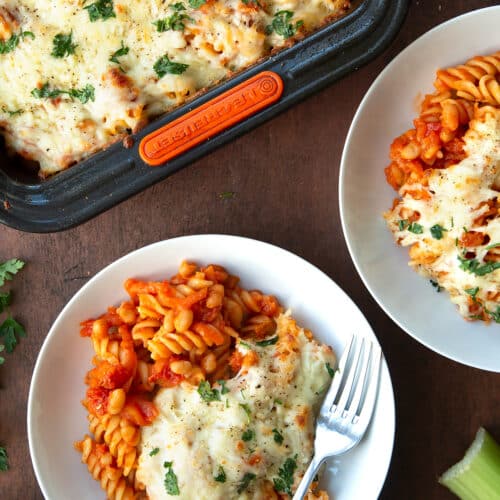


Leave a Reply